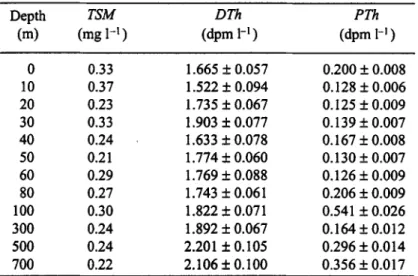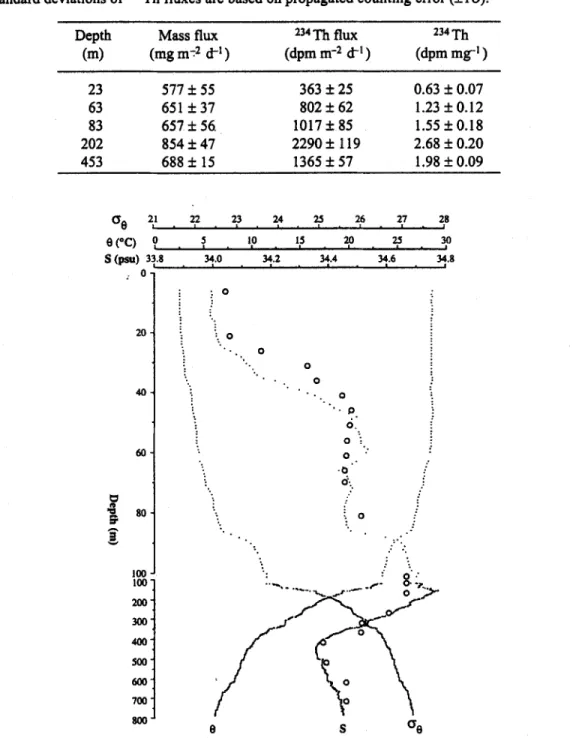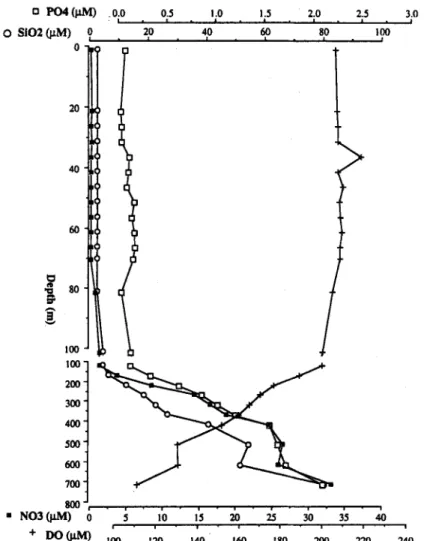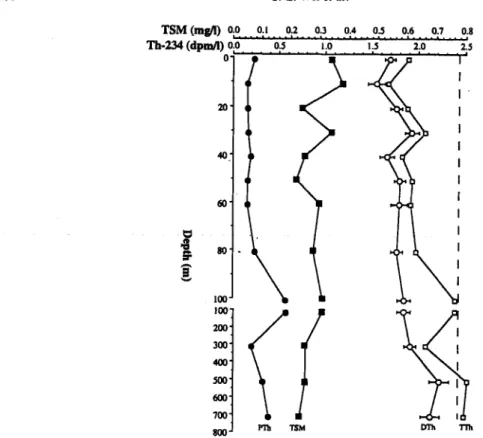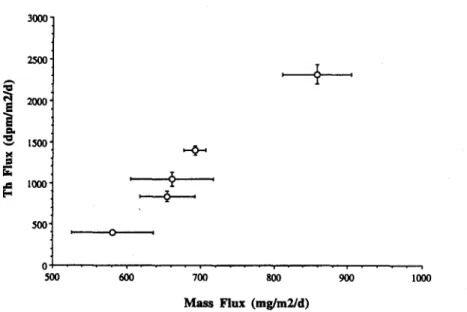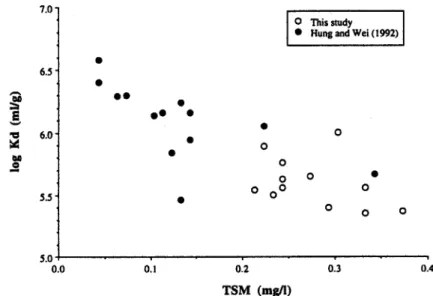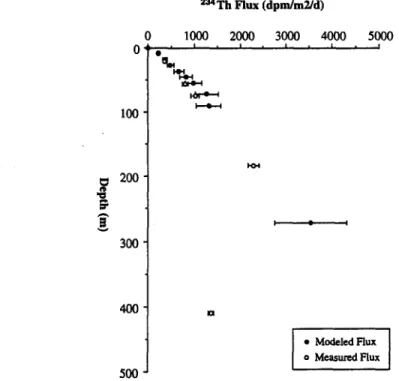Journal of Oceanography Vol. 50, pp. 403 to 414. 1994
Sediment Trap Experiments in the Water Column off
Southwestern Taiwan: 234Th Fluxes
CHING-LING WEi, KWUN~-Lt~G JEN and KENSON CHU
Institute of Oceanography, National Taiwan University, P.O. Box 23-13, Taipei, Taiwan, ROC (Received 4 December 1993; in revised form 16 February 1994; accepted 19 February 1994) The activity of 234Th (tl/z = 24.1 days) in dissolved, particulate and sediment trap samples was determined in the water column off southwestern Taiwan during 2 - 4 October, 1993. Vertical 234Th fluxes measured by the free-floating sediment traps ranged from 363 to 2290 dpm m -2 d -! in the upper 450 m. Th-234 fluxes predicted from the irreversible scavenging model concur with those measured by the sediment traps. Comparison of the residence times of particulate 234Th and par- ticulate organic carbon showed that their respective values differ by a factor of approximately 2-3, which suggests organic carbon is preferentially recycled relative to 234Th in the euphotic z o n e .
1. Introduction
Downward flux of particulate materials from ocean surface waters is the controlling mechanism for brifiging particle-reactive elements into the interior of the ocean (Goldberg, 1954). In recent years, oceanographers have been devoted to quantifying the material exchange rate between the surface layer and deep ocean. The disequilibria o f uranium-thorium series radionuclides serve as a powerful tool for investigating the scavenging and particle removal processes, while sediment traps provide the only direct method o f measuring vertical flux of particulate materials in the water column.
Multiple sediment traps mounted either on a free-floating (surface-tethered) or an anchored (bottom-tethered) mooring line have been used to study the particle dynamics in the upper ocean (Coale and Bruland, 1985, 1987; Murray etal., 1989; Wei and Murray, 1991, 1992). Depending on the individual site, discrepancies with variable extents exist between measured and expected 234Th fluxes. For example, in the eastern Equatorial Pacific Ocean (Murray et al., 1989) and the Black Sea (Wei and Murray, 1991) where free-floating traps were used, measured 234Th fluxes were greater than those calculated from the disequilibria of 234Th/23sU profiles. In Dabob Bay, a fjord in Puget Sound (USA), where anchored sediment traps were deployed, measured 234Th fluxes were smaller than calculated 234Th fluxes (Wei and Murray, 1992). Buesseler (1991) 9 evaluated the existing 234Th data and observed that the overall discrepancy can be as high as 3 ~ 10 folds. No definite explanation has been given for the disagreement between the measured and calculated 234Th fluxes. This study was designed to directly measure the vertical 234Th fluxes and 234Th/23sU disequilibria in the water column to see how the two approaches compare to each other.
In a previous paper (Hung and Wei, 1992) a vertical 234Th flux o f 1220 dpm m -2 d -I out o f the euphotic zone and a lower limit of 1600 dpm m -2 d -~ into the bottom sediment off south- western Taiwan was estimated from 234Th/238U disequilibria. This region (22~ N 120~ E, water depth = 750 m) was revisited to carry out sediment trap experiments and water column sampling. Vertical fluxes of total mass, 234Th, 2~0pb ' 210po ' trace metals, particulate organic carbon
404 C,-L. Wei e t al.
and nitrogen (POC and PON) were measured by sediment traps deployed at five depths in the water column. Vertical profiles of the aforementioned elements were also determined. This paper will report the 234Th data and address its relationship with particle cycling.
2. Method
This study was carried out during 2-4 October 1993, in the sea off southwestern Taiwan aboard the R/V Ocean Researcher I (cruise #368). Seawater samples and sediment trap samples were collected and processed as follows:
2.1 Seawater samples
Seawater was collected using 20 1 Go-Flo bottles mounted on a CTD rosette. To confirm depth, a salinity sample was taken fr.om each bottle and compared to the CTD profile. Samples to determine the concentration of dissolved oxygen, nutrients, chlorophyll a, POC, and PON were collected from separate casts. Compressed air (at 12 p.s.i.) was used to pressure filter seawater through preweighed 142 mm Nuclepore filters (0.45/.un pore size) mounted in a Plexiglas filter holder. The filters were rinsed with approximately 15 ml deionized distilled water to remove sea salt and stored in a petri dish to determine the total suspended matter (TSM) concentration and particulate 234Th activity. Parallel samples for dissolved and particulate 2 ~0pb
and 2t~ determinations were also collected. The 21~ and 2t0po results will be reported in a
separate paper.
Filtered seawater (~20 I) was transferred into a cubitainer, acidified with approximately 20 ml of concentrated HC1 and spiked with 35 dpm 23~ yield tracer as well as 60 mg Fe carrier. The samples were then aerated for at least 4 hours to help achieve isotopic equilibrium (Wei and Hung, 1993). Without interrupting the aeration, 12 N NaOH was added to raise the pH to 8. The Fe(OH)3 precipitates, with adsorbed thorium, were collected by siphoning and filtering, and then dissolved in concentrated HC1 to make the samples 9 N HCI. These samples were then passed through an anion exchange column (AG1X-8) and preconditioned by 9N HCI to separate uranium from thorium. Thorium passed through the column was collected and stored for later purification in the laboratory.
After weighing, the filters were decomposed in the laboratory by soaking in ~10 ml of concentrated NH4OH. The samples were gently heated to evaporate the NH4OH. Digestion and analytical procedures for determining particulate 234Th are described in Anderson and Fleer (1982).
2.2 Sediment trap samples
Settling particles were collected by particle interceptor traps (PITS) deployed at five depths (23, 63, 83,202 and 453 m). The sediment trap used in this study was a modified version of the
design by Knauer et al. (1979). Each set of sediment trap consists of eight Plexiglass tubes with
an aspect ratio of 9.53 and a erossframe made of polypropylene. Two types o f tube, with and without a filter holder on the bottom, were used. The tubes were snapped into the erossframe which was clamped onto a 500 m surface-tethered mooring line. The mooring line was 3/4" low stretch Dacron (Champion-braid). The duration of trap deployment was approximately 1.5 days. Similar sediment traps were used in other regions (Wei and Murray, 1991, 1992, 1994).
The trap solutions were prepared by adding approximately 800 g of NaCl to 201 of filtered subsurface seawater taken near the trap deployment location. Approximately 12 ml of 37% formaldehyde was added into each tube to prevent particle decomposition, except for the tubes
Sediment Trap Experiments in the Water Column 405
used in the POC/PON traps. Upon recovery, the upper layer o f seawater in the traps was siphoned off and the remaining trap solution was gravity drained through a pre-weighed 90 mm Nuclepore filter (0.45/.a'n pore size), which was mounted on the bottom o f the trap. While applying a slight vacuum, the filters were rinsed with approximately 10 ml ofdeionized distilled water to remove sea salt. Zooplankton swimmers were removed by hand under microscope. Generally, 5-10 copepods were found in the traps deployed in upper 100 m. The filterpapers were stored in a petri dish to determine total mass and 234Th. Total 234Th activity on the filters was determined by the same procedures as the particulate samples.
The activity o f 234Th in seawater samples and sediment trap samples was counted using a low background (<0.3 cpm) anticoincidence counter (Tennelec LB-5100) via its fl-emitting daughter 234pa. The purity o f the samples was. checked by taking repeated counting over a two month period to confirm that the radioactive decay curve was followed (Wei, 1991). Blank determina- tions o f all reagents and filter paper used for this study indicated negligible contribution. Chemical yield o f thorium was estimated by counting spiked 230Th using silicon surface-barrier detectors (EG&G Ortec 576). The counting efficiencies o f the tz detectors were calibrated against NIST traceable 241Am (Isotope Products Laboratory 387-67-2-2) and 23~ (Isotope Products Laboratory 387-67-3) standard plates. Activity o f 234Th in seawater samples was corrected back to the sampling time after the ingrowth o f 234Th from 238U was subtracted. Activity o f 23aTh in sediment trap samples was corrected back to the mid point o f trap deployment.
3. Results
Depth, concentration o f total suspended matter (TSM), dissolved (DTh) and particulate (PTh) 234Th activities are given in Table 1. The uncertainty in the radioisotope data was estimated according to the propagation o f counting error (+ 1 o-). Total mass fluxes, 234Th fluxes, and cal- culated specific 234Th activity in trap particles are listed in Table 2. Standard deviations o f mass fluxes were calculated from duplicate samples. Errors o f 234Th fluxes represent propagated
Table 1. Depth, total suspended matter (TSM) concentration, dissolved and particulate 234Th collected during 2-4 October 1993. Standard deviations are based on propagated counting error (+1 or).
Depth TSM DTh PTh (m) (mg I -t) (dpm 1 -I ) (dpm 1 -I ) 0 0.33 1.665 __+ 0.057 0.200 +__ 0.008 10 0.37 1.522 + 0.094 0.128 + 0.006 20 0.23 1.735 + 0.067 0. I25 + 0.009 30 0.33 1.903 + 0.077 0.139 __+ 0.007 40 0.24 1.633 + 0.078 0.167 + 0.008 50 0.21 1.774 + 0.060 0.130 __+ 0.007 60 0.29 1.769 + 0.088 0.126 + 0.009 80 0.27 1.743 + 0.061 0.206 + 0.009 100 0.30 1.822 + 0.071 0.541 __+ 0.026 300 0.24 1.892 + 0.067 0.164 + 0.012 500 0.24 2.201 :t: 0.105 0.296 __+ 0.014 700 0.22 2.106 + 0.100 0.356 __+ 0.017
4 0 6 C.-L. W e i e t al.
Table 2. Depth, total mass fluxes, 234Th fluxes, and specific 234Th activity in trap particles collected during 2-4 October 1993. Standard deviations o f total mass fluxes are calculated from duplicate samples. Standard deviations of 234Th fluxes are based on propagated counting error (4-1 or).
Depth M a s s f i u x 234 T h f i U X 234 T h (m) (mg m :2 d -l) (dpm m -2 d -I ) (dpm mg -I ) 23 577 :I: 55 363 4- 25 0.63 + 0.07 63 651 :!: 37 802 + 62 1.23 + 0.12 83 657-I- 56 1017 4- 85 1.55 4- 0.18 202 854 4- 47 2290 4- 119 2.68 4- 0.20 453 688 4- 15 1365 4- 57 1.98 4- 0.09 ~ 0 21 22 ~ 24 25 26 27 28 I i 1 | l I i I i i i i o ( o c ) 0 , 5, , ~p , ~s , 2o , ~ , 3o, S (pSU) 33.8 34.0 , 34.2, , 3 4 . 4 34C6 34C8 : 0 20 411 '~ 8o 100 100" 200" 300" 4 0 0 " 500" 6 0 0 " 700" 8OO :~ 0 " ' . . 0 "- O O 9 9 O ' ' ID O. O " ~ O .9 .. " 0 d': ." - o ~ 9 9 :.~ ~. .: - L ...
/ 5 \
O S O0Fig. 1. Vertical profiles o f temperature, salinity, and potential density. Salinities collected from bottle samples and measured by Autosal | are indicated by circles.
Sediment Trap Experiments in the Water Column 4 0 7
counting errors (+1o-). Hydrographic and nutrient data are not listed but are available upon request.
The vertical distributions of hydrographic data (salinity, potential temperature, and potential density) and dissolved oxygen/nutrients (PO4, NO3, and SiO2) at the sampling station are shown in Figs. 1 and 2, respectively. TSM concentration, dissolved and particulate 234Th activity with counting error bars are shown in Fig. 3. Total 234Th activity as the sum o f dissolved and particulate 234Th activities are also included in this figure. The dotted line drawn at 2.42 dpm 1-' represents 238U activity calculated from the S-23au relationship from Ku et al. (1977).
As pointed out in Hung and Wei (1992), the interleaving salinity structure (Fig. 1) is due to complicated water mixing in this area. The salinity maximum of 34.8 psu at 145 m is caused by the intrusion of the Kuroshio (Shaw, 1989). The main pycnocline occurred at depths of 80-
t3 PO4 (IxM) 9 0.0 0.5 1.0 1i5 2.0 2.5 3.0
- I I , I , I , I !
o sio2t~M) ? '2o 40 ~ 80 io~
| I | , * I | I 0 20 40 60 Ioo 2o0 3oo 400 6o0 7oo 9 NO3 0xM) 0 5 10 15 2o 25 30 35 40 + D U (J.tM) 100 120 140 " 160 180 200 220 240
408 C . - L . W e i e t al.
T S M (rag/I) o : o o:l....o:2... 0 . 3 o:4.., off.., o;6....o:7.., o:8 T h - 2 3 4 ( d p m / l ) 0:0 . . . . 0fl . . . t:o . . . . 1fl . . . . 2 : 0 2.5 0" ~ ' ' I ' 411 100' 100 200' 300' 400' 500' 6GO' 700' 800
/.
i f
TSM DTh TThFig. 3. Vertical profiles of total suspended matter concentration
(TSM),
total (TTh), dissolved(DTh)
andparticulate
(PTh)
234Th activities. The vertical dashed line at 2.42 dpm 1 -I represents 23sU activitycalculated from S-23sU relationship. Error bars represent uncertainties based on propagated counting e r r o r .
120 m. Nutrients were depleted in the mixed layer, then increased with depth in the pycnocline layer (Fig. 2). Dissolved oxygen decreased from saturation levels in the mixed layer to 185/zM at S maximum. Below the 200 m depth, dissolved oxygen continued to decrease and nutrients showed a monotonically increasing trend toward the bottom.
In general, vertical distributions o f dissolved and particulate 234Th (Fig. 3) are similar to that o f the previous study (Hung and Wei, 1992), except the 234Th-excess layer was not observed (or was not as evident). It can be seen that all dissolved 2a4Th activity was deficient relative to the 2 3 8 U activity. Both TSM concentration and particulate 234Th activity were relatively low throughout the water column and showed little vertical structure except a small particulate 234Th maximum o f 0.5 dpm 1-1 at 100 m. Except at 300 m, total 234Th activity is in equilibrium with 23sU at all depths below 100 m.
Vertical fluxes o f total mass and 234Th are shown in Fig. 4. Total mass flux increases from 580 mg m -2 d -t at 20 m to a maximum o f 850 mg m -2 d -t at 200 m, then decreases to 700 mg m -2 d -t at 450 m. The 234Th flux has a wider range, from 360 to 2290 dpm m -2 d -~, than the total mass flux. A maximum in 234Th flux was also observed at 200 m. As shown in Fig. 5, a tight correlation (r ~ = 0.97) exists between the total mass fluxes and 234Th fluxes.
Sediment Trap Experiments in the Water Column 409 100 200 300 40o 500 M a s s Flux (mg/m2/d) 300 400 500 600 700 800 9c0 I ~ 0 , . , . i . o . , . , . , . , 0" ThF MF 9 , - , . , . , . , . , .500 1000 1500 2000 2.500 3000 Flux (dpm/m2/d)
Fig. 4. Vertical fluxes of total mass and 234Th measured by sediment traps. Error bars associated with total mass fluxes and 234Th fluxes represent uncertainties based on the standard deviation from duplicate samples and propagated counting error, respectively.
3000 84
~ 2000'
, - , 1500'
,II 1 0 ~ '
) . . . . , . . . . , . . . . , , . . o . , . .
500 6O0 70O 8O0 90O
M a s s F l u x ( m g / m ~ d )
Fig. 5. Correlation of total mass flux and 234Th flux.
410 C.-L. Wei et al.
4. Discussion
In December 1991, vertical profiles of dissolved and particulate 234Th were determined at a sampling station about 30 Ion north of this study site. Box-model calculations for the data gave mean residence times of 100 days for dissolved 234Th and 20 days for particulate 234Th in the upper water column (100 m) (Hung and Wei, 1992). The same calculations were applied to the profiles obtained from this study and mean residence times of 90 days for dissolved 234Th and 14 days for particulate 234Th in the upper 100 m were estimated. The shorter dissolved 234Th residence time (~'Drh) is consistent with the fact that particle load at our sampling station was about 3 times higher than that of Hung and Wei (1992). The standing stocks of total suspended matter in the upper 100 m of our sampling station and Hung and Wei's (1992) were 28.3 g m -2 and 11.7 g m -2, respectively. Partitioning of 23+Th between particulate and solution phases was also affected by the particulate matter concentration. The correlation of distribution coefficient (Kd) of 23+Th and TSM concentrations from this study and the study by Hung and Wei (1992) is shown in Fig. 6. Good correlation Of Kd and TSM concentrations indicates internal consistency for the two sets of data obtained from the two cruises.
It should be noted that although the sampling site is near the coast (about 25 km offshore), the ~Vrh obtained from this study and Hung and Wei (1992) are both long compared to other coastal regimes, which typically have Z'Vrh values of days. Relatively long Z'VTh implies that the region has oligotrophic characteristics of the open ocean. Coale and Bruland (1985) observed the scavenging rate constant of dissolved 234Th (reciprocal of Z'DTh) is proportional to primary pro- ductivity in the California Current. A primary production rate of only 130 mg C m 2 d ~ was estimated if we assumed the proportionality can be applied to our station. It should be noted that a large uncertainty (~50%) may be associated with the estimate.
Recently, concerns regarding the validity of using PITS type sediment traps to determine the sinking particle flux have been raised. Buesseler (199 I) compared the existing 234Th fluxes
M _o 7.0" 6.5' 6.0' $.5' l O This study l Hung and Wei (1992)
0 0 9 0 0 0 0 0 o 0 0 9 0 0 0 0 ~.0
o.o oi~ o12 o13 oi,
TSM (mg/l)
Fig. 6. Correlation between the distribution coefficient (Kd) and total suspended particle (TSM) con- centrafion for data collected from this study (open circle) and Hung and Wei (1992) (solid circle).
Sediment Trap Experiments in the Water Column 411
measured directly by sediment traps and estimated from the irreversible scavenging model and concluded that the shallow sediment traps cannot provide accurate flux information due to a relatively large discrepancy (3 to I0 folds) between the two fluxes.
According to the irreversible scavenging model the panicle removal rate for 234Th (i.e., P flux, Coale and Bruland, 1985) can be calculated by
e-- z ( u - rrh)
(1)
where ;I. is the decay constant o f 234Th (0.0288 d-t), Uis 238U activity (dpm l-m), and TTh is total 234Th activity (dpm l-l). It should be noted that the P flux calculated from (1) has a rate unit, dpm 1-1 d -l. In order to compare with measured 234Th flux data the rate unit should be converted into a flux unit,
n x-- z[(P, + - (2) where P~ is successive P flux calculated from discrete 234Th data at depth Zi in the water column. The comparison o f modeled 234Th flux and measured 234Th flux is shown in Fig. 7.
It can be seen that234Th fluxes predicted from the model and measured by sediment traps are almost identical in the upper 100 m. The irreversible scavenging model predicted that the vertical 234Th flux continues to increase to 3700 dpm m -2 d -1 at the depth o f 300 m. Th-234 flux
234 T h F l u x (dpm/m2/d) 100 200 300 400 500 o lOOO i HHi.,e, 4 m 2000 3O00 4000 5000 i i t t I 9 Modeled Flux I J o Measured Flux
Fig. 7. Vertical fluxes of 234Th measured by sediment traps (open circle) and calculated from the irreversible scavenging model (solid circle). Error bars represent uncertainties based on propagated counting error.
412 C.-L. Wei et al.
at 200 m measured by the sediment trap falls on the linear interpolation line between the modeled fluxes at I00 and 300 m. For the deeper layer, the residence time of suspended particles is too long to be resolved by the 234Th/23su disequilibrium. Much less 234Th flux measured at 450 m indicates a net decomposition process for the suspended particles or a horizontal transport of particles in the mid-layer (~200 m). However, we suspect the later is important because no elevated TSM concentration was found (Fig. 3). The excellent agreement between the modeled and measured 234Th fluxes suggests our sediment trap does provide reliable vertical flux measurements in the euphotic layer off southwestern Taiwan. Although the results are very encouraging, potential problems with this type of sediment trap still exist (Buesseler, 1991). Furthermore, using simplified scavenging model to calibrate measured 234Th flux may not be valid because the model assumes a steady-state and neglects advection/diffusion effects on the distribution of 234Th.
Based on the findings that the scavenging rate constant of 234Th correlates with the primary production rate (Coale and Bruland, 1985) or with the flux of particulate organic carbon (Bruland and Coale, 1986), Eppley (1989) suggested that 234Th can be used as a tracer for organic carbon
in the euphoric zone to estimate new production. Murray et al. (1989) tested the hypothesis by
comparing the residence times of organic carbon and 234Th in the euphotic layer of the eastern equatorial Pacific. They found that the residence time of 234Th is approximately one third of carbon, and concluded that using 234Th as a carbon tracer was not justified. With data available in this study, we compared the residence times of total suspended matter (*'TSM), particulate 234Th (*'PTh), and particulate organic carbon (zPoc). The residence times were calculated by dividing the inventory of each parameter by flux out. The values for 234Th were also calculated by the irre- versible scavenging model. The results are summarized in Table 3.
The zPn~ in the upper 60 m is 8~12 days when calculated from the water column 234Th data or 11 days when calculated from the sediment trap flux. Generally, the Z'pTh calculated from the two approaches agree well with each other. The Z'Poc in the same layer is 25 days, approximately 2-3 times the *'pa'h. The difference between Z'PTh and Z'Poc seems to be a common feature shared by different oceanic regimes. Coale and Bruland (1985) observed that z'rrh is about half the Z'poc
in the California Current system while Murray et al. (1989) demonstrated that Z'pTh is about one
third of carbon in the eastern equatorial Pacific. As a result, new production will be overestimated by a factor of 2~3 if Z'pa'h was assumed to be an estimate of z'Poc. The ~sm (26 days) is similar to the ~'poc, implying that the biogenic particles dominate the bulk suspended load in the upper 60 m of the site.
Table 3. Residence times of total suspended matter ('PrSM), particulate 234Th ('rPTh), and particulate organic carbon (rpoc) in the upper 60 m.
zrrh (day)
~'TSM (daY) PTh/~(U- TTh)* ZPTh/ThF** ~'wc (daY)
26 8-12 11 25
*Based on the mass balance equation for particulate 234Th: 0 = d P T h / d t -~ 2 ( U - D T h ) - 2 P T h - P.
Sediment Trap Experiments in the Water Column 413
5. C o n c l u s i o n
A h o m e - m a d e sediment trap was successfully deployed in the sea o f f southwestern Taiwan to directly measure the vertical fluxes o f total mass and 234Th. At the same location, large volume seawater samples were also taken to measure the dissolved and particulate 234Th profiles. A comparison o f the 234Th fluxes predicted from the water c o l u m n 234Th data and measured by the sediment trap was made and excellent agreement found between the two values. It was concluded that 234Th cannot quantitatively trace organic carbon in the euphotic layer, and new production will be overestimated b y a factor o f 2~3 i f the residence time o f particulate 234Th is used as an export rate parameter for carbon.
A c k n o w l e d g e m e n t s
W e are grateful for the support (NSC82-0209-M-002A-041) o f the National Science Council, Taiwan, Republic o f China. Mr. G.-Y. H u a n g and the crew o f R/V Ocean Researcher I provided skillful assistance with trap deployment. W e acknowledge the assistance o f Dr. G. -C. G o n g and Mr. W.-R. Yang in measuring the salinity and nutrients and Dr. Y.-L. Li's effort in measuring the primary productivity. W e would also like to thank Dr. K.-K. Liu and Mr. C. -L. Lai for allowing us to use their POC and PON data before publication. C o m m e n t s made by a n o n y m o u s reviewers substantially improved the manuscript.
References
Anderson, R. F. and A. P. Fleer (1982): Determination of natural actinides and plutonium in marine particulate material. Anal. Chem., 54, 1142-1147.
Bruland, K. W. and K. H. Coale (1986): Surface water 234Th/238U disequilibria: Spatial and temporal variations of scavenging rates within the Pacific Ocean. p. 159-172. In Dynamic Processes in the Chemist~ of the Upper Ocean, ed. by J. D. Burton, P. G. Brewer and R. Chesselet, Plenum Pub. Co.
Buesseler, K. O. (1991): Do upper-ocean sediment traps provide an accurate record of particle flux? Nature, 353, 420-423.
Coale, K. H. and K. W. Bruland (1985): 234Th:238U disequilibria within the California Current. LimnoL Oceanogr., 30, 22-33.
Coale, K. H. and K. W. Bruland (1987): Oceanic stratified euphotie zone as elucidated by 234Th:238U disequilibria. Limnol. Oceanogr., 32, 189-200.
Eppley, R. W. (1989): New production: history, methods and problems, p. 85-97. In dahlem Workshops in "'Productivity of the Ocean: Present and Past", ed. by W. H. Berger, V. Smetacek and O. WelTer, Wiley, New York.
Goldberg, E. D. (1954): Marine Chemistry 1. Chemical scavengers of the sea../. Geol., 62, 249-265.
Hung, C.-C. and C.-L. Wei (1992): Th-234 scavenging in the water column off southwestern Taiwan. TA O, 3, 183- 197.
Knauer, G. A., D. M. Karl, J. H. Martin and K. W. Bruland (1979): Fluxes of particulate carbon, nitrogen and phosphorus in the upper water column of the north-east Pacific waters. Deep-Sea Res., 26, 97-108.
Ku, T. L., K. G. Knauss and G. G. Mathiew (1977): Uranium in open ocean: concentration and isotopic composition. Deep-Sea Res., 24, 1005-1017.
Martin, J. H., G. A. Knaner, D. M. Karl and W. W. Broenkow (1987): VERTEX: Carbon cycling in the northeast Pacific. Deep-Sea Res., 34, 267-285.
Murray, J. W., J. N. Downs, S. Strom, C.-L. Wei and H. W. Jannasch (1989): Nutrient assimilation, export production and 234Th scavenging in the Eastern Equatorial Pacific. Deep-Sea Res,, 36, 1471-1489.
Shaw, P.-T. (1989): The intrusion of water masses into the sea southwest of Taiwan. J. Geophys. Res., 94, 18213- 18226.
Wei, C.-L. (1991): Studies of scavenging phenomenon in the upper water column off Northeast Taiwan-- Application of 234Th/238U disequilibrium. Acta Oceanographica Taiwanica, 26, 13-19.
414 C.-L. Wr et aL
Wei, C.-L. and C.-C. Hung (1993): The effect of isotopic equilibration time on the determination of 234Th in seawater. J. Radioanal. Nucl. Chem. Lett., 175, 155-159.
Wei, C.-L. and J. W. Murray (1991): 234Th/238U disequilibria in the Black Sea. Deep-Sea Res., 38, s855-s873. Wei, C.-L. and 3. W. Murray (1992): Temporal variation of 234Th activity in the water column of Dabob Bay: Particle
scavenging. Limnol. Oceanogr., 37, 296-314
Wei, C.-L. and J. W. Murray (1994): The behavior of scavenging isotopes in marine anoxic environments: Lead- 210 and polonium-210 in the water column of the Black Sea. Geochim. Cosmochim. dcta, $8, 1795-1811.
